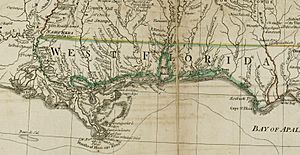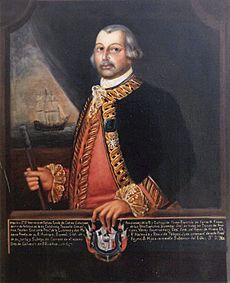Capture of Fort Bute facts for kids
Quick facts for kids Capture of Fort Bute |
|||||||
|---|---|---|---|---|---|---|---|
| Part of the Gulf Coast campaign | |||||||
 Detail from a 1776 map showing British West Florida |
|||||||
|
|||||||
| Belligerents | |||||||
| Commanders and leaders | |||||||
| Bernardo de Gálvez | Cap. von Haake |
||||||
| Strength | |||||||
| 1,430 regulars, militia, & natives | 23 Hessian grenadiers | ||||||
| Casualties and losses | |||||||
| none | 1 killed 16 captured |
||||||
The Capture of Fort Bute was an important event at the start of Spain's involvement in the American Revolutionary War. Spain joined the war to help France and the United States. Bernardo de Gálvez, the Governor of Spanish Louisiana, led a group of Spanish soldiers, local fighters, and Native Americans. They attacked and captured the small British fort on Bayou Manchac on September 7, 1779. This victory showed that Spain was ready to fight against the British.
Contents
Why Did the Battle Happen?
Spain Joins the American Revolution
Spain officially entered the American Revolutionary War on May 8, 1779. King Charles III of Spain declared war on Great Britain. On July 8, he allowed his people in the colonies to start fighting the British.
Bernardo de Gálvez, the Governor of Spanish Louisiana, heard this news on July 21. He quickly began to plan secret attacks. Gálvez had been thinking about war since April. He found out that the British in Pensacola were planning a surprise attack on New Orleans. So, he decided to attack them first. To keep his plans secret, he did not tell the public about the king's war order right away.
What Were the British Defenses Like?
Fort Bute's Location and Condition
Fort Bute was located on Bayou Manchac. This was about 115 miles (185 km) up the Mississippi River from New Orleans. It was on the far western edge of British West Florida.
Lieutenant Colonel Alexander Dickson was in charge of defending the Baton Rouge area. This area included Fort Bute, Baton Rouge, and Fort Panmure (which is now Natchez, Mississippi). The British had sent more soldiers to this area. This happened after George Rogers Clark captured Vincennes, which showed how weak British defenses were.
British Troops in the Area
In August 1779, Dickson had about 400 regular soldiers. These included troops from the 16th and 60th Regiments. There was also a new company of grenadiers from Waldeck, a German state. About 150 local fighters who supported the British were also there.
Fort Bute was an old fort built in 1766. It was in very bad condition. Dickson thought it could not be defended. When Dickson heard about Spanish movements, he moved most of his soldiers to Baton Rouge and Panmure. He left only a small group of 20 Waldeck soldiers at Fort Bute. Captain von Haake led these soldiers.
How Did the Spanish March to Fort Bute?
Gálvez first planned to leave New Orleans on August 20. But a strong hurricane hit the town on August 18. It sank most of his ships and destroyed their supplies.
Even with this setback, Gálvez did not give up. He got support from the colony. On August 27, he started marching his troops by land towards Baton Rouge. He told everyone they were moving to defend Spanish Louisiana from a British attack.
Who Was in Gálvez's Army?
The force leaving New Orleans had 520 regular Spanish soldiers. About two-thirds of these were new recruits. There were also 60 local fighters, 80 free men of color, and ten American volunteers. Oliver Pollock led the American volunteers. As they marched upriver, more people joined. About 600 more men joined, including Native Americans and Acadians.
At its largest, the army had over 1,400 people. But the difficult march caused many to leave. Several hundred men were lost before they reached Fort Bute.
The Attack on Fort Bute
When the army got close to Fort Bute on September 6, Gálvez told them the truth. He announced that Spain had declared war and explained their real mission. The men cheered when they heard this.
At dawn the next day, they attacked the fort. There was a short fight, and one German soldier was killed. Most of the soldiers in the fort surrendered. Six soldiers escaped and went to Baton Rouge to tell Dickson what happened.
What Happened After the Battle?
Gálvez stayed at Fort Bute for six days. This gave his men time to rest. Then, he moved on to Baton Rouge. Baton Rouge fell after a short siege on September 21. The agreement Dickson made at Baton Rouge meant that all other British outposts on the Mississippi River also surrendered to Gálvez.
After this victory, Gálvez went back to New Orleans. He started planning new campaigns. His next targets were Mobile and Pensacola. These were the last British strongholds in West Florida.
Images for kids
See also
 In Spanish: Captura de Fort Bute para niños
In Spanish: Captura de Fort Bute para niños




